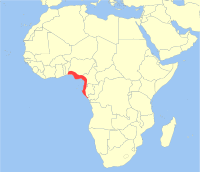- Collared mangabey
-
Collared mangabey[1] 
Conservation status Scientific classification Kingdom: Animalia Phylum: Chordata Class: Mammalia Order: Primates Family: Cercopithecidae Genus: Cercocebus Species: C. torquatus Binomial name Cercocebus torquatus
(Kerr, 1792)
Geographic range The collared mangabey (Cercocebus torquatus), also known as the red-capped mangabey, white-collared mangabey[3] (leading to easy confusion with Cercocebus atys lunulatus), or cherry-crowned mangabey[4], is a species of primate in the Cercopithecidae family of Old World monkeys. It formerly included the sooty mangabey as a subspecies. As presently defined, the collared mangabey is monotypic.[1]
Contents
Range
It is found in forests, especially near water, from western Nigeria, east and south through Cameroon and Equatorial Guinea, to Gabon. It is now critically endangered because of habitat loss. [2]
Description
The collared mangabey, at birth, can reach anywhere from 5 cm to 18 cm. The mangabey typically goes through this life cycle: 9–11 months gestation, 6–11 years to sexual maturity, and overall lifespan of approximately 30 years. When a juvenile, the mangabey can reach about 35 cm, and at adulthood, they can get to be up to 50 cm long and weigh 60 pounds.
Diet
The collared mangabey enjoys certain kinds of fruit, including mangoes, peaches, and tropical pears. In zoos worldwide, they will also eat apple slices and bananas. The mangabey is considered an omnivore.
Behaviour
The collared mangabey is an extremely social species. In the wild, they will typically live in groups of 7-10 animals, sometimes even 20. The social group is usually made up of about two males for breeding and protection, approximately three females for breeding, about 2 females for foraging for food, and their young.
References
- ^ a b Groves, C. (2005). Wilson, D. E., & Reeder, D. M, eds. ed. Mammal Species of the World (3rd ed.). Baltimore: Johns Hopkins University Press. pp. 154. OCLC 62265494. ISBN 0-801-88221-4. http://www.bucknell.edu/msw3/browse.asp?id=12100433.
- ^ a b Oates, J. F., Gippoliti, S. & Groves, C. P. (2008). Cercocebus torquatus. In: IUCN 2008. IUCN Red List of Threatened Species. Downloaded on 4 January 2009.
- ^ Rowe, N. (1996). The Pictorial Guide to the Living Primates. Pogonia Press, Charlestown, Rhode Island. ISBN 0-9648825-0-7.
- ^ http://www.colchester-zoo.co.uk/index.cfm?fa=conservation.list
This Old World monkey-related article is a stub. You can help Wikipedia by expanding it.


